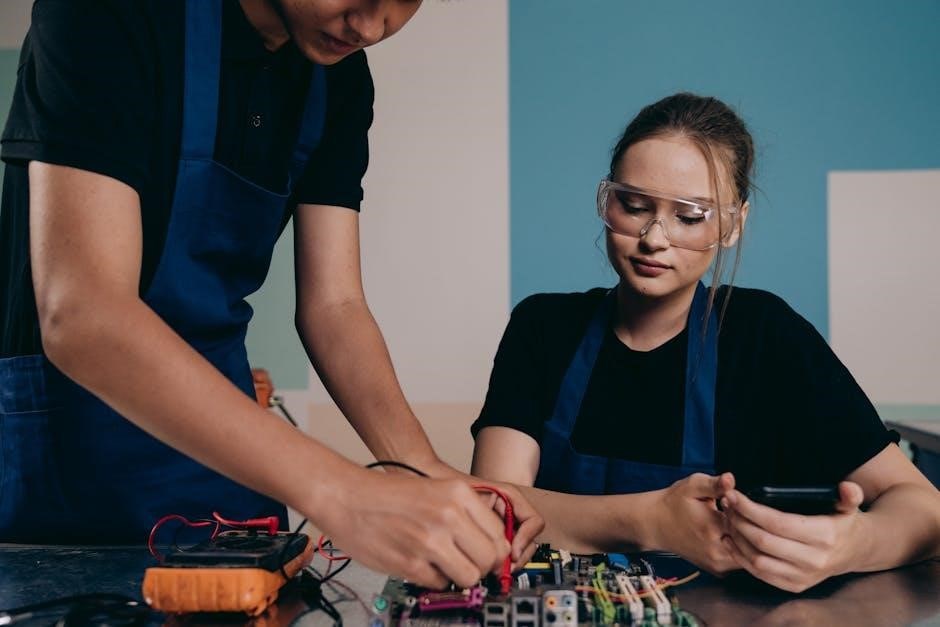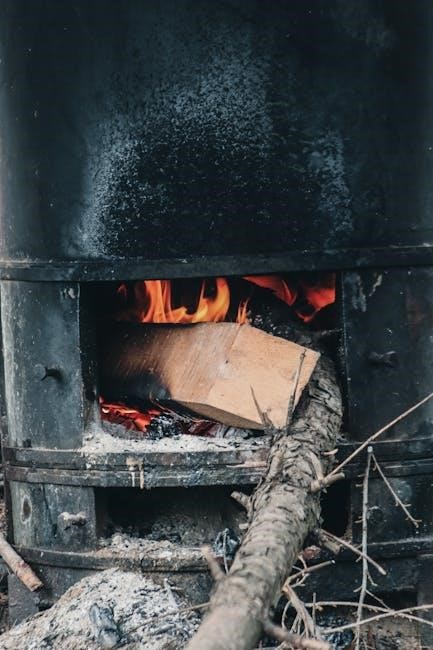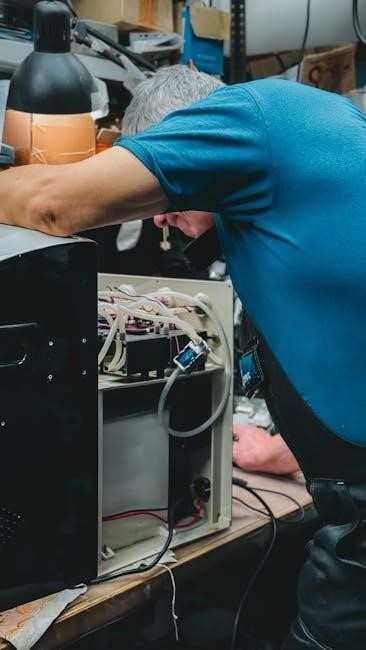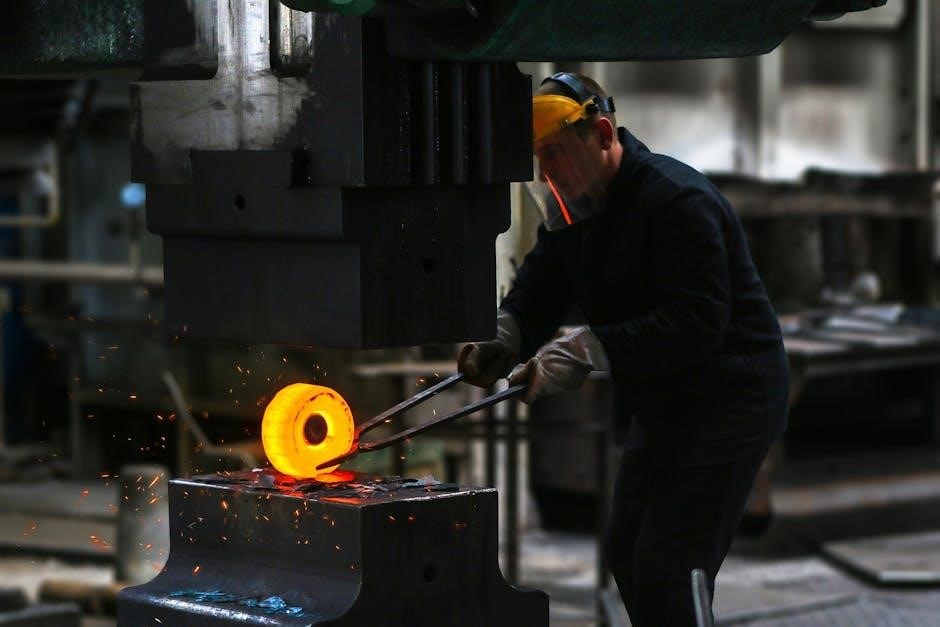Carrier furnaces are high-efficiency heating systems designed for reliability and comfort. However, like any HVAC system, they can experience issues requiring troubleshooting. Understanding the basics of furnace operation and maintenance is essential for identifying and resolving common problems. Carrier furnace troubleshooting manuals provide detailed guidance, ensuring safe and effective diagnostics. By following these resources, homeowners and technicians can address malfunctions, optimize performance, and extend the system’s lifespan.

Proper troubleshooting techniques also help maintain energy efficiency and safety standards. Always consult the official Carrier furnace manual for model-specific instructions and safety guidelines before starting any repair.

Safety Precautions for Furnace Troubleshooting
Before troubleshooting your Carrier furnace, ensure your safety by following essential precautions. Always turn off the gas supply and electrical power to the furnace. Allow the unit to cool down completely before starting any inspection. Never operate the furnace without a proper filter or with the blower access door removed, as this can damage internal components. Check the manual reset switch for continuity and press it if necessary. Consult the Carrier furnace manual for specific safety guidelines and procedures to avoid potential hazards or system damage.
2.1. Essential Safety Measures Before Starting
Before beginning any troubleshooting on your Carrier furnace, it is crucial to take several essential safety measures to protect yourself and ensure the process is conducted safely and effectively. First, always turn off the gas supply to the furnace by shutting the external manual shutoff valve. This prevents any potential gas leaks or accidental ignition during the troubleshooting process. Additionally, switch off the electrical power to the furnace at the circuit breaker or fuse box. Allow the furnace to cool down completely, as the components may remain hot for a period after shutdown.
Next, check the manual reset switch located in the gas control area. This switch may have tripped due to a detected fault and must be reset manually. Ensure the switch is functioning properly and press it if necessary. Always verify that the furnace is completely powered down before attempting any internal inspections or repairs. Proper ventilation in the room is also important to prevent the accumulation of harmful gases or fumes.
Use only the appropriate tools and equipment for troubleshooting to avoid damaging the furnace or causing injury. Refer to the official Carrier furnace manual for specific instructions and safety guidelines tailored to your model. Wearing protective gear, such as gloves and safety glasses, is highly recommended when working with electrical or gas components. Finally, never attempt to troubleshoot the furnace while it is operational or under warranty without consulting a certified technician. By adhering to these essential safety measures, you can minimize risks and ensure a safe troubleshooting experience.
2.2. Key Safety Guidelines to Follow
When troubleshooting your Carrier furnace, adhering to key safety guidelines is paramount to prevent accidents and ensure a safe working environment. Always begin by familiarizing yourself with the furnace’s components and their functions, as outlined in the official Carrier furnace manual. This knowledge will help you identify potential hazards and handle them appropriately. Never bypass safety features or disable alarms, as these are designed to protect both you and the system from damage.
When working with electrical components, ensure that all power sources are disconnected before starting any repairs. Use a voltage tester to confirm that there is no live electricity in the system. If you encounter any sparks, unusual odors, or sounds during troubleshooting, stop immediately and contact a certified technician. Additionally, always follow proper lockout/tagout procedures to prevent accidental startup of the furnace while you are working on it.
Gas safety is another critical aspect of furnace troubleshooting. If you suspect a gas leak, open windows for ventilation, avoid using electrical appliances, and do not ignite any flames. Never attempt to repair gas lines or valves without proper training and tools. If in doubt, always err on the side of caution and seek professional assistance. By following these key safety guidelines, you can ensure a safe and effective troubleshooting process for your Carrier furnace.

Common Issues in Carrier Furnaces

Carrier furnaces, like any HVAC system, can encounter common issues that affect their performance. One of the most frequent problems is the furnace not turning on, often due to thermostat malfunctions or power supply issues. Another issue is insufficient heat production, which may stem from clogged air filters, faulty ignitors, or improper gas flow. Additionally, blower motor malfunctions can disrupt airflow, leading to uneven heating.
These issues can often be resolved by referencing the Carrier furnace troubleshooting manual, which provides step-by-step solutions and maintenance tips to restore optimal function. Always consult the manual before attempting repairs to ensure safety and effectiveness.
3.1. Furnace Not Turning On
One of the most common issues with Carrier furnaces is the system failing to turn on. This can be caused by a variety of factors, including power supply problems, thermostat malfunctions, or issues with the furnace’s internal components. Understanding the root cause is essential to resolving the problem effectively.
First, check the power supply to ensure the furnace is receiving electricity. Verify that the circuit breaker or fuse box has not tripped or blown a fuse. If the issue persists, inspect the thermostat settings to ensure it is set to “heat” mode and that the desired temperature is higher than the current room temperature.
Next, examine the furnace switch, which is often located near the unit. If the switch is off, the furnace will not operate. Additionally, check the gas supply (for gas furnaces) to ensure the valve is open and functioning properly.
If these steps do not resolve the issue, the problem may lie within the furnace’s internal components, such as the ignitor or control board. Refer to the Carrier furnace troubleshooting manual for specific diagnostic procedures. Consulting a professional technician may be necessary if the issue persists, as improper repairs can lead to safety hazards or further damage. Always prioritize safety and follow the guidelines outlined in the manual when attempting repairs.
3.2. Insufficient Heat Production
Insufficient heat production is another common issue with Carrier furnaces, leaving homeowners uncomfortable during colder months. This problem can arise from various factors, including dirty air filters, blocked vents, or malfunctioning components. Identifying the cause is crucial for restoring proper heating.

Start by inspecting the air filter. A dirty or clogged filter restricts airflow, reducing the furnace’s ability to heat efficiently. Replace or clean the filter as recommended in the Carrier furnace manual. Next, check for blocked vents or ducts, as obstructions can prevent warm air from circulating through the home.
If the issue persists, examine the thermostat settings. Ensure the thermostat is functioning correctly and is set to the appropriate temperature. Consider upgrading to a smart thermostat for better control over heating levels.
Another potential cause is a malfunctioning gas valve or ignition system. If the furnace fails to ignite properly, it cannot produce heat. Refer to the troubleshooting guide in the Carrier manual for steps to diagnose and address ignition issues. Low gas pressure can also impact performance, requiring adjustment by a qualified technician.
Finally, duct leaks or insulation issues in the home can lead to heat loss, making the furnace appear less efficient. Sealing ducts and improving insulation can significantly improve heating performance. Always follow the manufacturer’s guidelines and safety precautions when performing repairs; If the problem remains unresolved, contact a certified Carrier technician to ensure the system operates safely and efficiently.
